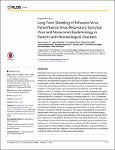Long-Term Shedding of Influenza Virus, Parainfluenza Virus, Respiratory Syncytial Virus and Nosocomial Epidemiology in Patients with Hematological Disorders
Lehners, Nicola
Tabatabai, Julia
Prifert, Christiane
Wedde, Marianne
Puthenparambil, Joe
Weissbrich, Benedikt
Biere, Barbara
Schweiger, Brunhilde
Egerer, Gerlinde
Schnitzler, Paul
Respiratory viruses are a cause of upper respiratory tract infections (URTI), but can be associated with severe lower respiratory tract infections (LRTI) in immunocompromised patients. The objective of this study was to investigate the genetic variability of influenza virus, parainfluenza virus and respiratory syncytial virus (RSV) and the duration of viral shedding in hematological patients. Nasopharyngeal swabs from hematological patients were screened for influenza, parainfluenza and RSV on admission as well as on development of respiratory symptoms. Consecutive swabs were collected until viral clearance. Out of 672 tested patients, a total of 111 patients (17%) were infected with one of the investigated viral agents: 40 with influenza, 13 with parainfluenza and 64 with RSV; six patients had influenza/RSV or parainfluenza/RSV co-infections. The majority of infected patients (n = 75/111) underwent stem cell transplantation (42 autologous, 48 allogeneic, 15 autologous and allogeneic). LRTI was observed in 48 patients, of whom 15 patients developed severe LRTI, and 13 patients with respiratory tract infection died. Phylogenetic analysis revealed a variety of influenza A(H1N1)pdm09, A(H3N2), influenza B, parainfluenza 3 and RSV A, B viruses. RSV A was detected in 54 patients, RSV B in ten patients. The newly emerging RSV A genotype ON1 predominated in the study cohort and was found in 48 (75%) of 64 RSV-infected patients. Furthermore, two distinct clusters were detected for RSV A genotype ON1, identical RSV G gene sequences in these patients are consistent with nosocomial transmission. Long-term viral shedding for more than 30 days was significantly associated with prior allogeneic transplantation (p = 0.01) and was most pronounced in patients with RSV infection (n = 16) with a median duration of viral shedding for 80 days (range 35–334 days). Long-term shedding of respiratory viruses might be a catalyzer of nosocomial transmission and must be considered for efficient infection control in immunocompromised patients.
Dateien zu dieser Publikation
Keine Lizenzangabe
Verwandte Publikationen
Anzeige der Publikationen mit ähnlichem Titel, Autor, Urheber und Thema.
-
2011-10-12ZeitschriftenartikelNo Detection of XMRV in Blood Samples and Tissue Sections from Prostate Cancer Patients in Northern Europe. Stieler, Kristin; Schindler, Sarah; Schlomm, Thorsten; Hohn, Oliver; Bannert, Norbert; Simon, Ronald; Minner, Sarah; Schindler, Michael; Fischer, NicoleBackground: We recently published the rare detection of xenotropic murine leukemia virus-related virus (XMRV) (1/105) in prostate cancer (PCA) tissue of patients in Northern Europe by PCR. The controversial discussion ...
-
2010-06-01ZeitschriftenartikelXenotropic Murine Leukemia Virus–related Gammaretrovirus in Respiratory Tract Fischer, Nicole; Schulz, Claudia; Stieler, Kristin; Hohn, Oliver; Lange, Christoph; Drosten, Christian; Aepfelbacher, MartinXenotropic murine leukemia virus–related gammaretrovirus (XMRV) has been recently associated with prostate cancer and chronic fatigue syndrome. To identify nucleic acid sequences, we examined respiratory secretions by using ...
-
2016-09-16ZeitschriftenartikelBrincidofovir clearance of acyclovir-resistant herpes simplex virus-1 and adenovirus infection after stem cell transplantation Voigt, Sebastian; Hofmann, Jörg; Edelmann, Anke; Sauerbrei, Andreas; Kühl, J. S.Infections with adenovirus (AdV) and herpesviruses can result in considerable morbidity and mortality in pediatric hematopoietic stem cell transplant (SCT) recipients. Herpes simplex virus (HSV) reactivations are usually ...

